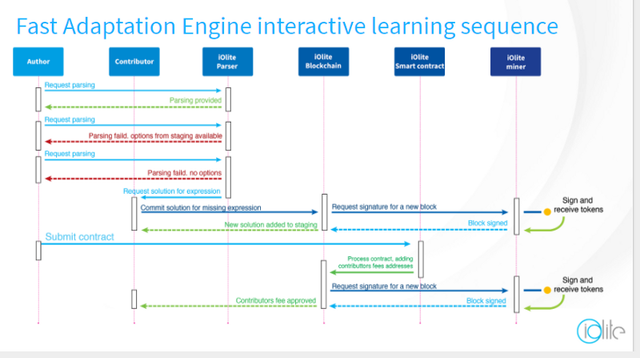
This post will help you to understand how the iOlite process works. Below, you see the sequence of the Fast Adaptation Engine (FAE).
Different Elements
- Author (~ requester for solution): Person who is trying to write a smart contract for a specific use.
- Contributor: Smart contract developer who is taking the unknown expressions and defines the structures for it.
- iOlite Parser: Grammar lexical engine from Stanford.
- iOlite Blockchain: Place we store information about transactions and structures. We will first start using Ethereum. However, as Ethereum is overloaded and not adapted for our specific use case, we will build our own iOlite blockchain. Why? We try to make the most effective nodes for our use case which have to hold mostly dictionary info instead of historical info about transactions. That’s the reason we want to start with a clean blockchain and make it more suitable for languages.
- iOlite smart contract: This can be an Ethereum smart contract in the beginning, but we want to move to iOlite smart contracts which are optimized for natural language processing (NLP).
- iOlite Miner: very similar to Ethereum miner which gives iOlite tokens (iLT) as a reward.
Use Cases
Use case 1:
We start writing an expression that gets picked up by the iOlite parser. The parser immediately finds a translation in its expressions pool. In this case, the parser returns the created smart contract code. This is the most ideal and fastest possible solution.
Use case 2:
We submit an expression to the parser, but the parser isn’t able to find a solution for this request. However, although he couldn’t find the correct structures in the main domain, there is a solution available in the staging domain created which is not yet approved by the iOlite team. The requester can decide whether he wants to use this solution.
Use case 3:
Parsing failed, and there are no options available from staging. Now, contributors will get a notification there is an unsolved expression. If a contributor finds a solution, he can submit the structures which make part of this solution to the iOlite blockchain to be stored. The blockchain request a signature for the new block containing the solution from the iOlite miner. If the contributor used other contributors’ work, they will receive iOlite tokens as a reward because of this reuse.
At this point, the solution is added to the staging phase. After approval from the iOlite team, the requester can actually deploy the created smart contract on the iOlite blockchain. The contributor will get a fee for his work from the miner who processes the deployment of the smart contract. In this way, the author of the expression doesn’t have to pay for the whole process.
Check out iOlite website: https://iolite.io

Hi! I am a robot. I just upvoted you! I found similar content that readers might be interested in:
https://medium.com/@iolite/explanation-of-iolite-flow-and-its-fae-ddab3db2d6c7
good job bot! yeah we published the same article in Medium
Congratulations @hosammazzawi! You have received a personal award!
Click on the badge to view your own Board of Honor on SteemitBoard.
Congratulations @hosammazzawi! You received a personal award!
You can view your badges on your Steem Board and compare to others on the Steem Ranking
Do not miss the last post from @steemitboard:
Vote for @Steemitboard as a witness to get one more award and increased upvotes!